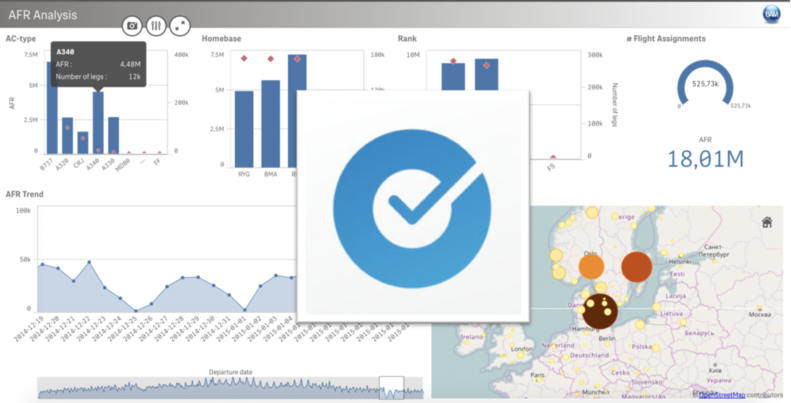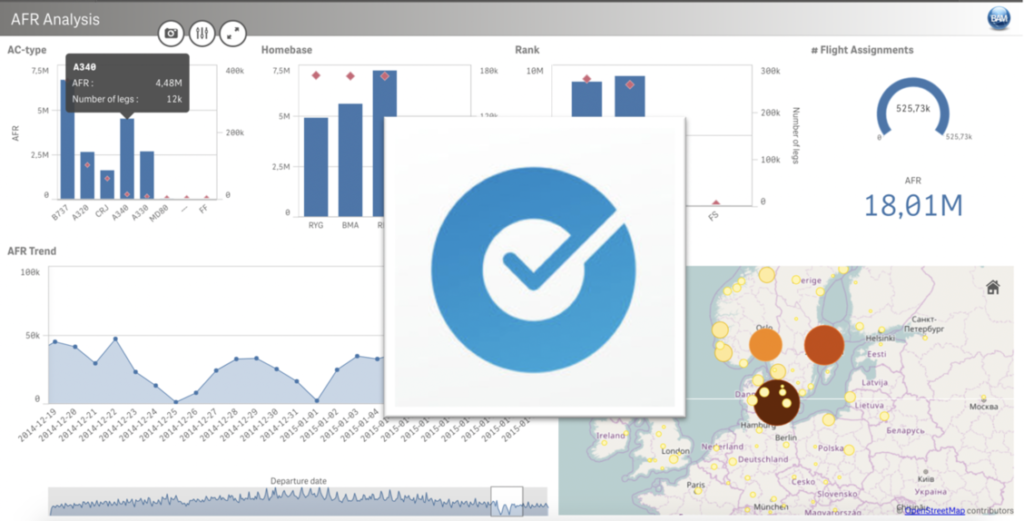
FRM News Flash – July 2019
Crew Management and FRM at the Paris Air Show

At the recent Paris Air Show, Boeing announced new orders and agreements for digital solutions that harness the power of big data to significantly expand fleet capability and cost savings for commercial and government customers. The announcement included new orders and renewals of crew management and FRM solutions for Cathay Pacific Group, Interglobe Aviation (Indigo), JetBlue Airways and United Airlines.
Jeppesen Concert – on the Move!

Jeppesen Concert continues to advance its position as the most comprehensive FRM analytics solution for aviation. Concert can be connected to any crew management system and provides a powerful fully cloud-based self-service analytics solution, powered by Qlik Sense.
Recent additions to the platform are:
• Improved integration with CrewAlert Pro
• Request/response interface for any crew management solution to easily ‘query’ Concert on-line
• Two-factor authentication using Okta
• Improved user management enabling streamlined access for extended user groups
• Automatic periodical reports informing on identified SPI trends
Please find more information about Jeppesen Concert here, and please contact us if you would like a demo or a trial on your own data – identifying hotspots and trends in, say, the last five years of operation?
How to Cope with Night Time Work
 Working night time is challenging for most of us. Day time sleep is normally shorter and more fragmented, making it far too easy to accumulate a sleep debt when working consecutive nights.
Working night time is challenging for most of us. Day time sleep is normally shorter and more fragmented, making it far too easy to accumulate a sleep debt when working consecutive nights.
Please find a few coping strategies in this article from Medical News Today, that may be of help.
Is Your TTM Short Enough?
 TTM, or Time To Market, is a metric used in crew management defined as ‘the average duration from start of the crew planning optimization process, to flown production’.
TTM, or Time To Market, is a metric used in crew management defined as ‘the average duration from start of the crew planning optimization process, to flown production’.
A short TTM is crucial for allowing the network organisation (commercial planning) to adjust the flight schedule and fleet plan as long as possible, in order to maximize captured revenue. TTM is short when an airline has a short crew planning process and frequently publish roster content to crew.
However, TTM not only affects the operator’s ability to tune revenue capture, something increasingly important in a fast moving market, but also has its implications on crew fatigue risk. With a lengthy crew planning process, airlines often end up publishing rosters to their crew that later will need to be changed when for example charter flights are inserted, fleets are being swapped, or capacity doesn’t match the demand. Late changes to the rosters are detrimental to crew fatigue risk as sleep often takes a hit when personal life and work content clashes. Good roster planning practices include:
- Plan late, and fast, using the most accurate data. This does not need to conflict with giving crew long heads-up on their time off.
- Build in buffers to legal limits and other operational constraints that risks making the plan break down in day of operation
- Provide crew with influence over their rosters (through bids, requests, swaps and special contracts)
- Use validated science (a bio-mathematical model such as BAM) to suppress and distribute risk while building your pairings and rosters
- Protect the most challenging part of the operation from late changes
Read more about controlling crew fatigue risk throughout the crew management process in this document.
Jeppesen provides solutions that enables airlines to drastically shorten their planning process, such as Jeppesen Crew Pairing and Rostering. Get in touch with us if you would like to learn more.
Meet up with the Jeppesen experts:
SEP 9-13: Shiftwork & Working Time Symposium, Coeur d’Alene, Idaho
SEP 19: 2019 FRM Conference Taiwan, Taipei
OCT 1-2: FRMS Forum, San Fransisco
OCT 8-9: FRM Training Course, Gothenburg
OCT 21-24: Jeppesen Users Conference, Dubai
MAR 16-19: Managing Fatigue 2020, Freemantle
Crew Management and FRM at the Paris Air Show

At the recent Paris Air Show, Boeing announced new orders and agreements for digital solutions that harness the power of big data to significantly expand fleet capability and cost savings for commercial and government customers. The announcement included new orders and renewals of crew management and FRM solutions for Cathay Pacific Group, Interglobe Aviation (Indigo), JetBlue Airways and United Airlines.
Jeppesen Concert – on the Move!

Jeppesen Concert continues to advance its position as the most comprehensive FRM analytics solution for aviation. Concert can be connected to any crew management system and provides a powerful fully cloud-based self-service analytics solution, powered by Qlik Sense.
Recent additions to the platform are:
• Improved integration with CrewAlert Pro
• Request/response interface for any crew management solution to easily ‘query’ Concert on-line
• Two-factor authentication using Okta
• Improved user management enabling streamlined access for extended user groups
• Automatic periodical reports informing on identified SPI trends
Please find more information about Jeppesen Concert here, and please contact us if you would like a demo or a trial on your own data – identifying hotspots and trends in, say, the last five years of operation?
How to Cope with Night Time Work
 Working night time is challenging for most of us. Day time sleep is normally shorter and more fragmented, making it far too easy to accumulate a sleep debt when working consecutive nights.
Working night time is challenging for most of us. Day time sleep is normally shorter and more fragmented, making it far too easy to accumulate a sleep debt when working consecutive nights.
Please find a few coping strategies in this article from Medical News Today, that may be of help.
Is Your TTM Short Enough?
 TTM, or Time To Market, is a metric used in crew management defined as ‘the average duration from start of the crew planning optimization process, to flown production’.
TTM, or Time To Market, is a metric used in crew management defined as ‘the average duration from start of the crew planning optimization process, to flown production’.
A short TTM is crucial for allowing the network organisation (commercial planning) to adjust the flight schedule and fleet plan as long as possible, in order to maximize captured revenue. TTM is short when an airline has a short crew planning process and frequently publish roster content to crew.
However, TTM not only affects the operator’s ability to tune revenue capture, something increasingly important in a fast moving market, but also has its implications on crew fatigue risk. With a lengthy crew planning process, airlines often end up publishing rosters to their crew that later will need to be changed when for example charter flights are inserted, fleets are being swapped, or capacity doesn’t match the demand. Late changes to the rosters are detrimental to crew fatigue risk as sleep often takes a hit when personal life and work content clashes. Good roster planning practices include:
- Plan late, and fast, using the most accurate data. This does not need to conflict with giving crew long heads-up on their time off.
- Build in buffers to legal limits and other operational constraints that risks making the plan break down in day of operation
- Provide crew with influence over their rosters (through bids, requests, swaps and special contracts)
- Use validated science (a bio-mathematical model such as BAM) to suppress and distribute risk while building your pairings and rosters
- Protect the most challenging part of the operation from late changes
Read more about controlling crew fatigue risk throughout the crew management process in this document.
Jeppesen provides solutions that enables airlines to drastically shorten their planning process, such as Jeppesen Crew Pairing and Rostering. Get in touch with us if you would like to learn more.
Meet up with the Jeppesen experts:
SEP 9-13: Shiftwork & Working Time Symposium, Coeur d’Alene, Idaho
SEP 19: 2019 FRM Conference Taiwan, Taipei
OCT 1-2: FRMS Forum, San Fransisco
OCT 8-9: FRM Training Course, Gothenburg
OCT 21-24: Jeppesen Users Conference, Dubai
MAR 16-19: Managing Fatigue 2020, Freemantle